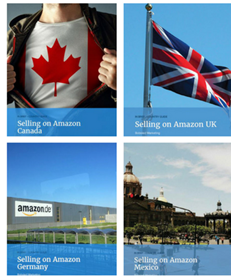💡 This article was published in 2015. Since then, we shared new information. Here's a recent post:
Amazon offers a huge opportunity for brands selling physical products. The good news is that selling on Amazon is not just limited to US residents and corporations - it is possible to sell on Amazon in the US without ever setting foot on US soil.
This 4-part series will walk through the process of setting up an Amazon Seller Account as a foreigner, as well as the ins and outs of importing your products, getting paid, and expanding beyond the US. Make sure you sign up to our mailing list to get notified when new articles come out!

Note: I offer this information as a starting point. You should always check the rules & regulations in your own country as well as the current information provided by Amazon & the US federal government. You should also consult with a tax advisor to help you decide the best options from a personal tax planning standpoint.
Part 1: Process & Requirements for setting up an
Amazon US / North America Account
The first step is to selling on Amazon is to register for an account. An obvious first move, but what is not so obvious is all the decisions you’ll have to make about how to set up your account.
Decision 1: Individual or Professional Seller
The graphic below shows the differences between the two types of accounts you can create on Amazon. The Individual Selling Plan is suited to lower-volume sellers who will be selling less than 40 units per month. Above 40 units, you may as well be on the Professional Selling Plan and pay the $39.95 monthly fee. You must also be on the Professional Selling Plan to sell in certain product categories.
*Note: this post was written in February 10, 2016, and a few things have changed since then! The Professional Selling Plan was updated at 39.99 USD$ per month, in March 1, 2018.

Decision 2: Fulfillment - FBA or Merchant Fulfilled
This decision related to how you get your products to customers.
We’re fierce proponents of FBA (Fulfilled by Amazon) and see it as the best way to sell 90% of products on Amazon. Customers trust you & your products more, shipping costs can be lower for both you & the customer, and you have the ease of having Amazon store your inventory and manage orders for you.
Here’s how FBA works as an international seller:
- You enroll in the FBA program after creating a Seller account in that country marketplace (e.g. USA)
- You import your products to the US and have them delivered to Amazon’s fulfillment center(s), whereby Amazon will ship items directly to US customers. More about importing requirements & processes in Part 3
- Amazon handles storage of your inventory, picking & packing customer orders, customer service, and returns. The fees for these services are the same for foreign Sellers as US-based sellers.
- Customer returns are sent back to the Amazon fulfillment centers, and if the item is sellable, it will be re-stocked and sold again. But for damaged or defective stock can only be returned to a US address or destroyed by Amazon. This is something you’ll need to figure into your costs and/or processes.

Related: planning to expand your business to international markets using Amazon? We have just the right thing for you. Click here to receive access to our dedicated country guides that will teach you how to start selling on Amazon Canada, Germany, UK and Mexico.
Decision 3: Taxpayer status
All Professional Sellers and those with over 50 transactions in a calendar year must submit their tax information to Amazon.
When setting up an account, you’ll go through a Taxpayer Wizard which will generate an IRS tax form for you to complete. Foreign sellers still need to complete the tax interview, and it’s likely that the form which is generated for you is a W9-BEN form, which means you’ll be exempt from U.S. tax reporting requirements.
This is good news, because foreign persons are not subject to U.S. income tax withholding if performing the work outside the U.S. Of course, you may stillhave to pay tax on this income in your own country. And if you set up a US-based corporation or LLC, that entity will be considered a US “person” and therefore subject to paying income tax.
So the decision to make here is whether to create a business entity in the US, or maintain status as a foreign individual. Be sure to consult a tax professional to determine the best action in your case.
Getting approval in your product category
Some product categories require manual approval to sell in. Some of the more popular categories include:
- Beauty / Health & Personal Care
- Clothing & Accessories
- Collectibles & Fine Art
- Grocery & Gourmet Food
- Jewelry, Watches
- Luggage, Shoes, Handbags & Sunglasses
*Note: this post was written in February 10, 2016, and a few things have changed since then! The following product categories list has been updated in March 1, 2018.
- Automotive & Powersports
- Clothing & Accessories
- Collectible Books
- Entertainment Collectibles
- Gift Cards
- Industrial & Scientific
- Jewelry
- Luggage & Travel Accessories
- Major Appliances
- Shoes, Handbags & Sunglasses
- Sports Collectibles
- Toys & Games (holiday approval only)
Watches
Getting approval in these categories usually involves demonstrating to Amazon that you’re a legitimate manufacturer or brand. They want to ensure that you have substantial enough business to warrant the effort of reviewing your products and brands, and that you are not at risk of supplying low-quality or defective products. The type of information requested varies, but may include Purchase Orders or Receipts from suppliers and Business Registration documents.
See all the product categories and any selling restrictions right here.
Other requirements specific to registering on Amazon US
To create an account, you’ll also need to provide:
- A valid credit card which can be used for international transactions (fees etc)
- Phone number. Using a service like Viber Out or getting a US Skype number will make your life much easier, since Amazon Seller Support reportedly only calls US numbers.
Stay tuned for Part 2 of this series, where we'll discuss how to get paid for your sales on Amazon; bank accounts; taxes; and selling fees.
Don’t miss the other parts of this 4-part blog series on how to sell on Amazon as a non-US resident!
Part 1: Process for Setting up an Amazon Account as a non-US Resident (this article).
Part 2: Getting paid as a non-US Amazon FBA Seller
Part 3: Importing Products to the US to Sell on Amazon
Part 4: Beyond the Amazon America / US Marketplace
.png)
